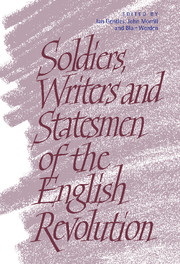Book contents
- Frontmatter
- Contents
- Preface
- Austin Woolrych: an appreciation
- 1 Secret alliance and Protestant agitation in two kingdoms: the early Caroline background to the Irish Rebellion of 1641
- 2 Of armies and architecture: the employments of Robert Scawen
- 3 George Digby, Royalist intrigue and the collapse of the cause
- 4 The iconography of revolution: England 1642–1649
- 5 The casualties of war: treatment of the dead and wounded in the English Civil War
- 6 ‘A bastard kind of militia’, localism, and tactics in the second civil war
- 7 Cromwell's commissioners for preserving the peace of the Commonwealth: a Staffordshire case study
- 8 Colonel Gervase Benson, Captain John Archer, and the corporation of Kendal, c. 1644—c. 1655
- 9 Repacifying the polity: the responses of Hobbes and Harrington to the ‘crisis of the common law’
- 10 Equality in an unequal commonwealth: James Harrington's republicanism and the meaning of equality
- 11 John Milton and Oliver Cromwell
- 12 From pillar to post: Milton and the attack on republican humanism at the Restoration
- 13 ‘They that pursew perfaction on earth …’: the political progress of Robert Overton
- 14 Locke no Leveller
- A bibliography of the writings of Austin Woolrych, 1955-95
- Index
1 - Secret alliance and Protestant agitation in two kingdoms: the early Caroline background to the Irish Rebellion of 1641
Published online by Cambridge University Press: 10 November 2009
- Frontmatter
- Contents
- Preface
- Austin Woolrych: an appreciation
- 1 Secret alliance and Protestant agitation in two kingdoms: the early Caroline background to the Irish Rebellion of 1641
- 2 Of armies and architecture: the employments of Robert Scawen
- 3 George Digby, Royalist intrigue and the collapse of the cause
- 4 The iconography of revolution: England 1642–1649
- 5 The casualties of war: treatment of the dead and wounded in the English Civil War
- 6 ‘A bastard kind of militia’, localism, and tactics in the second civil war
- 7 Cromwell's commissioners for preserving the peace of the Commonwealth: a Staffordshire case study
- 8 Colonel Gervase Benson, Captain John Archer, and the corporation of Kendal, c. 1644—c. 1655
- 9 Repacifying the polity: the responses of Hobbes and Harrington to the ‘crisis of the common law’
- 10 Equality in an unequal commonwealth: James Harrington's republicanism and the meaning of equality
- 11 John Milton and Oliver Cromwell
- 12 From pillar to post: Milton and the attack on republican humanism at the Restoration
- 13 ‘They that pursew perfaction on earth …’: the political progress of Robert Overton
- 14 Locke no Leveller
- A bibliography of the writings of Austin Woolrych, 1955-95
- Index
Summary
This is an essay in British and to a lesser extent in European history. By exploring Anglo-Irish politics during the late 1620s and early 1630s it seeks to be doubly topical, shedding light on the British problem as well as on the background to the Irish rebellion of 1641. We have a growing awareness of the importance of British events, of the interplay of developments in the three kingdoms, in the coming of the crisis of the 1640s. The Irish rebellion, for example, helped set the English political stage for civil war by preventing the dissolution of the Long Parliament. Indeed the theory has recently been advanced that Ireland was the critical element in the British problem.4 Moreover, amongst Irish historians, how far back to trace the causes of the 1641 rebellion is still a controversial question.
These two dimensions, the British and the more particularly Irish, will be illuminated here by an investigation of a hitherto missing link in Irish political history.
The lords justices, Cork and Loftus, governed Ireland between 1629 and 1633. These years in Irish politics, between the departure of Falkland and the coming of Wentworth, have not received as much attention as they deserve. It is tempting to focus on the commencement of Wentworth's deputyship as a pivotal point. But the government of the lords justices had its own character and a wider historical significance. We can better understand both the character and the significance when we learn of a secret political player in London – an English and a European figure – and of his role in facilitating the aims of an ideological regime in Ireland.
- Type
- Chapter
- Information
- Publisher: Cambridge University PressPrint publication year: 1998
- 2
- Cited by

